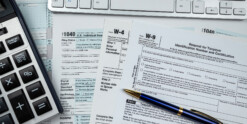A few weekends ago I spent some time reorganizing my outdoor storage shed. It was time to get the bikes, car seats and strollers under control. While moving around these heavy, awkwardly shaped items, though, I was wearing exactly what I’ve told my children not to wear during projects like this… flip flops. Just as I was starting to see some progress, part of a heavy iron trailer hitch fell off of a waist-high shelf directly on one of my toes.
After some hopping around and a few choice words, I finally sat down to get a better look at the damage and it appeared broken. Now this is not my first broken toe. I’ve been through the process of pain, swelling, and finally healing, so I know what to expect in the upcoming weeks and possibly months.
Once I finally sat down to properly gauge the damage, I found myself thinking, “Great, first it’s a rough week with the markets, now this just adds insult and injury.” Reflecting on both these things now, I find it funny that they’re actually fairly similar events. For every dramatic hammering that beseeches the stock market, there is a relatively slow healing process that follows… just like a broken toe.
Before last week’s mini-stabilization, we experienced one of the most dramatic stock market sell-offs since the financial crisis. Last Monday alone the DOW was down over 1000 points by 10 a.m. As of last week, the market (S&P 500) officially entered correction territory.
The last several weeks for stock investors has clearly been painful which then begs the question, how long will it take for markets to heal? How long does it take for stock investors to fully recover losses experienced in what is typically a quick and painful drop, much like what we experienced during the July-August rout of more than 2000 points on the Dow?
Just like a broken toe, corrections take some time to heal. Fortunately, though, the recovery time may be less than you think. Looking back on the S&P 500 Index from 1965 to 2014, I’ve calculated that:
• There have been a full fourteen 10-20% corrections (before this one)
• There have been another eleven corrections of more than 20%
• For the 10+% corrections, it takes about four months on average
• For the 20% + full-on bear markets, it takes about twenty-four months on average
There’s no doubt in my mind that corrections are painful for almost anyone who’s invested. It can be unsettling to look at your 401k where you’ve diligently socked away money only to see significantly fewer dollars than were in there yesterday. However, history has shown us that for all the S&P 500’s crashes, falls and plummets, it has always managed to eventually recover making corrections temporary.
Market corrections might not be pleasant, but it’d be much more unpleasant to miss out on the benefits of being invested in the stock market. Remember that historically the US large cap market has appreciated approximately 10% per year. This means that investors are able to double their money (on average) about every 7.2 years.
Now we’ve clearly been reminded that it’s rarely a steady increase, and typically toggles between dips and jumps. Ultimately, the way to enjoy that 10% average is to be invested for 20, 30, 50 or even 100 years and not give into the fear of the corrections that happen along the way.
Bottom Line
There’s no such thing as easy money. Making money in stocks takes time, conviction and patience. We will continue to see market corrections; however, when the “trailer hitch” falls we just need to remember that like a broken toe it might be painful… but the stock market will heal.
Read the original article here.













